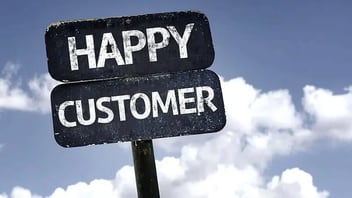How to Deal With Angry Customers or Clients
Ah, the angry customer. We've all had and been them, but do we know the best ways to care for them?

Treating your customers well seems like a no-brainer, doesn't it? In today's business climate, one wrong step or unpleasant customer experience can send someone you thought was devoted to you and only you running to your nearest competitor. Don't let that happen.
Specific best practices will, of course, vary by industry, customer type, etc. However, we've gleaned a few tips and tricks over the years that can go a long way toward keeping your customers happy and content with your service.
Empathy is the key to great customer relations.
Customers don't want repeated apologies, hollow platitudes, or empty promises. They want to feel that you truly understand their situation and are doing everything you can to help them. When it comes to customer service, empathy can take several forms:
-
Show that you're listening. Repeat the reported problem, change the wording a little, then add something that shows you're listening and not just repeating them. "I see, it sounds like you tried restarting the device, and now it doesn't show any lights. That's not what you expected this morning; let's get you up and running." This goes a long way toward helping the customer keep their cool and lets your CS rep do what they need to to help.
-
Don't place blame, make excuses, or apologize excessively. The customer doesn't want, or need, to hear that their problem is because of a breakdown in communication between Bob and Sally in engineering. They need to know the problem has been found, addressed and when they'll be able to get back to work. Apologizing repeatedly doesn't show empathy, either. It shows a lack of creativity on the part of the representative. Focus on your work to resolve the issue, and the customer will remember how hard your company worked to help them.
-
Respond specifically to the customer's complaint. And include details from their case and do it in a way that addresses the strain you know they're feeling without permitting them to escalate. See above for an example. Notice the CS rep didn't say, "I bet this is frustrating." If they had, even if the customer wasn't frustrated, they'd also been permitted to express that emotion.
-
Be quick about it. According to the Harvard Business Review, most people respond better to fast, ineffective responses to complaints than slow but comprehensive ones. Even no response at all scored higher than a slow one.
-
Set, and keep expectations. Your support team should already have SLAs (Service Level Agreements) for customer support interactions. Are these posted somewhere the customer can see them? This shows the customer that you value their time and understand that they have things they need to do other than sitting on hold or waiting for a response. This also allows you to wow them by getting in touch sooner than stated and staying in touch with updates.
Customers have multiple ways to reach you, so be sure you're there to respond.
In today's business environment, customers don't always use traditional means to contact a company. They may tweet at you. Or they may post a Facebook update, calling your company out for some perceived slight. Show the world (because that's who's watching you on social media) that you understand this business climate by responding in-channel.
Don't cross channels.
Look at it like this, if a customer tweets at your customer care account, it would be a little creepy if they got a phone call in response, right? Using social media is how people communicate with companies, so responding in kind shows that you value the customer's time and aren't require them to go through a lengthy ticket submission process or sit on hold unless necessary. It also shows that your company understands social media's value in brand recognition and reputation.
That means social media, too.
The world is watching your presence on Twitter, Facebook, Instagram, etc. Hence, it pays to have a dedicated customer service rep, or team, that monitors the corporate accounts watching for complaints, issues, and requests. By responding to these promptly (remember, social media is about instant gratification), you can win over even the most ardent complainers.
There will be exceptions.
Sometimes, responding via social media isn't appropriate, say if a customer's personal information is involved. Taking these interactions offline is fine by following up with a phone call.
Just ask first.
Go one better than that and ask for their preferred channel type for any necessary follow-up. Maybe they only use Facebook Messenger or don't have a working phone line, so email is the best option.
Again, you're showing that you understand where the customer is coming from and that you and your company are flexible enough to go where they are to resolve their issue.
Let's wrap it up with a special add-on tip.
Keep a single point of contact for the customer throughout their experience.
It's generally acknowledged that multiple support people will likely be involved in resolving any customer issue. However, there's no reason for them to repeatedly tell their story to each new team member brought into the loop.
Maintaining a single point of contact lets the customer know that this person is on top of their problem and will be there until it's resolved. It puts a name on an otherwise anonymous company. It's then up to the CS rep to bring in other teams or escalate to management as required, as long as they are the ones to get back to the customer. This simplifies the whole experience for the customer, and who doesn't appreciate a simplified experience?
According to the HBR study referenced above, consumers with positive experiences with a brand are three times more likely to recommend it to their friends and family. This applies even to companies they don't do business with. You can maintain your company's reputation and help it grow and expand to new markets simply by taking care of your existing customers wherever they might reach out.









Leave a Comment